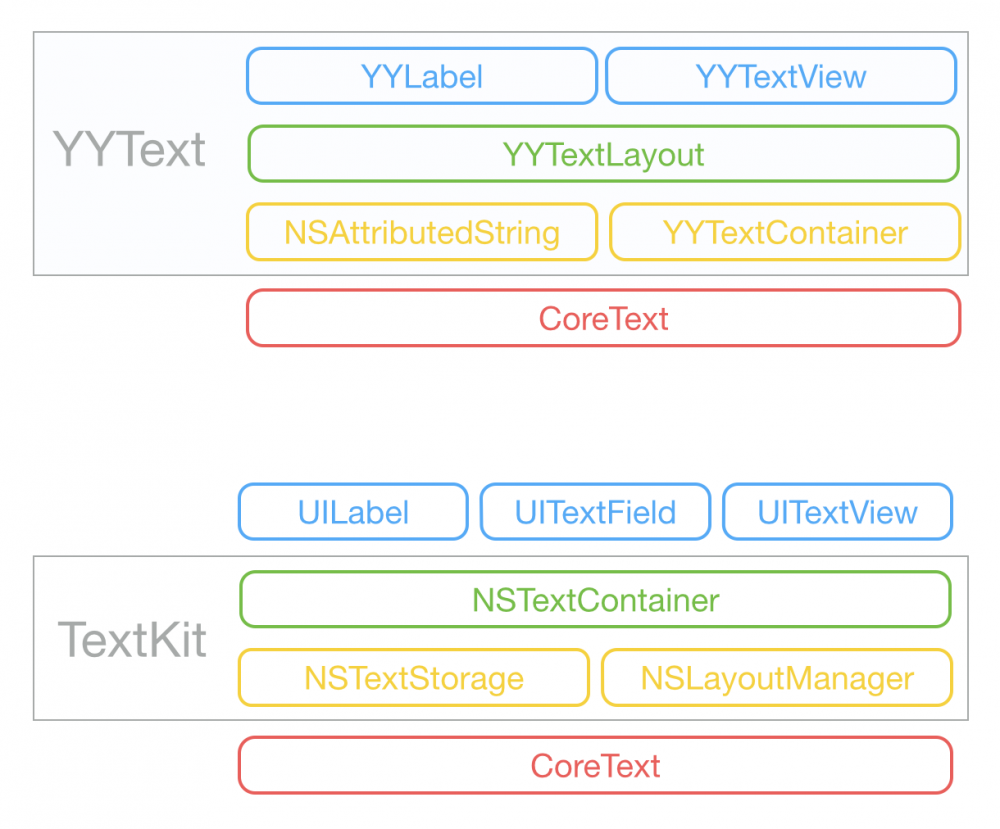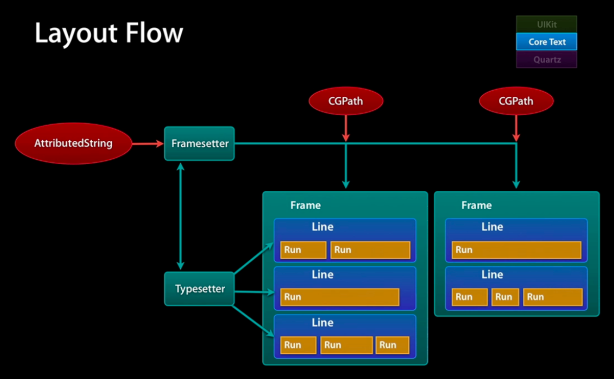YYText
YYText 是YYKit中的一个富文本显示,编辑组件,拥有YYLabel,YYTextView 两个控件。其中YYLabel类似于UILabel,但功能更为强大,支持异步文本渲染,更丰富的效果显示,支持UIImage,UIView, CALayer 文本附件,自定义强调文本范围,支持垂直文本显示等等。YYTextView 类似UITextView,除了兼容UITextView API,扩展了更多的CoreText 效果属性,支持高亮链接,支持自定义内部文本路径形状,支持图片拷贝,粘贴等等。
下面是YYText 与 TextKit 的比较图:

YYLabel
YYLabel 的实现,是基于 CoreText 框架 在 Context 上进行绘制,通过设置 NSMutableAttributedString 实现文本各种效果属性的展现。下面是YYLabel 主要相关的部分:
- YYAsyncLayer: YYLabel的异步渲染,通过YYAsyncLayerDisplayTask 回调渲染
- YYTextLayout: YYLabel的布局管理类,也负责绘制
- YYTextContainer: YYLabel的布局类
- NSAttributedString+YYText: YYLabel 所有效果属性设置
YYAsyncLayer 的异步实现
YYAsyncLayer 是 CALayer的子类,通过设置 YYLabel 类方法 layerClass
返回自定义的 YYAsyncLayer ,重写了父类的 setNeedsDisplay , display 实现 contents 自定义刷新。 YYAsyncLayerDelegate 返回新的刷新任务 newAsyncDisplayTask 用于更新过程回调,返回到 YYLabel 进行文本渲染。其中 YYSentinel 是一个线程安全的原子递增计数器,用于判断更新是否取消。
YYTextLayout
YYLabel 实现了 YYAsyncLayerDelegate 代理方法 newAsyncDisplayTask ,回调处理3种文本渲染状态willDisplay ,display,didDisplay 。在渲染之前,移除不需要的文本附件,渲染完成后,添加需要的文本附件。渲染时,首先获取 YYTextLayout , 一般包含了 YYTextContainer 和 NSAttributedString 两部分, 分别负责文本展示的形状和内容。不管是渲染时和渲染完成后,最后都需要调用 YYTextLayout 的
- (void) drawInContext:(CGContextRef)context
size:(CGSize)size
point:(CGPoint)point
view:(UIView *)view
layer:(CALayer *)layer
debug:(YYTextDebugOption *)debug
cancel:(BOOL (^)(void))cancel{
其中 context 是图形上下文,文本的绘制在它上面进行, size 是 context 的大小, point 是绘制的起始点, view , layer 是添加文本附件的视图(层), debug 调试选项, cancel 取消绘制,根据传入的文本是否需要绘制YYText自定义属性效果依次进行相应的绘制。有以下这些属性:
///< Has highlight attribute @property (nonatomic, readonly) BOOL containsHighlight; ///< Has block border attribute @property (nonatomic, readonly) BOOL needDrawBlockBorder; ///< Has background border attribute @property (nonatomic, readonly) BOOL needDrawBackgroundBorder; ///< Has shadow attribute @property (nonatomic, readonly) BOOL needDrawShadow; ///< Has underline attribute @property (nonatomic, readonly) BOOL needDrawUnderline; ///< Has visible text @property (nonatomic, readonly) BOOL needDrawText; ///< Has attachment attribute @property (nonatomic, readonly) BOOL needDrawAttachment; ///< Has inner shadow attribute @property (nonatomic, readonly) BOOL needDrawInnerShadow; ///< Has strickthrough attribute @property (nonatomic, readonly) BOOL needDrawStrikethrough; ///< Has border attribute @property (nonatomic, readonly) BOOL needDrawBorder;
以其中的 needDrawShadow 为例,在Demo中 YYTextAttributeExample.m , 为文本 Shadow 自定义了 textShadow , 在 NSAttributedString+YYText.m 中 调用 addAttribute:(NSString *)name value:(id)value range:(NSRange)range 添加了此文本属性。可以在 YYTextAttribute 查看所有属性信息
最后在 YYTextLayout 的初始化方法中获取,代码如下:
layout.needDrawText = YES;
void (^block)(NSDictionary *attrs, NSRange range, BOOL *stop) = ^(NSDictionary *attrs, NSRange range, BOOL *stop) {
if (attrs[YYTextHighlightAttributeName]) layout.containsHighlight = YES;
if (attrs[YYTextBlockBorderAttributeName]) layout.needDrawBlockBorder = YES;
if (attrs[YYTextBackgroundBorderAttributeName]) layout.needDrawBackgroundBorder = YES;
if (attrs[YYTextShadowAttributeName] || attrs[NSShadowAttributeName]) layout.needDrawShadow = YES;
if (attrs[YYTextUnderlineAttributeName]) layout.needDrawUnderline = YES;
if (attrs[YYTextAttachmentAttributeName]) layout.needDrawAttachment = YES;
if (attrs[YYTextInnerShadowAttributeName]) layout.needDrawInnerShadow = YES;
if (attrs[YYTextStrikethroughAttributeName]) layout.needDrawStrikethrough = YES;
if (attrs[YYTextBorderAttributeName]) layout.needDrawBorder = YES;
};
[layout.text enumerateAttributesInRange:visibleRange options:NSAttributedStringEnumerationLongestEffectiveRangeNotRequired usingBlock:block];
根据 YYTextContainer 和 NSAttributedString 生成 YYTextLayout ,接下来就是渲染了, 具体的渲染由 CoreText 来实现。
CoreText
CoreText 是iOS/OSX里的文字渲染引擎,在iOS/OSX上看到的所有文字在底层都是由CoreText去渲染。

一个 NSAttributeString 通过CoreText的 CTFramesetterCreateWithAttributedString 生成 CTFramesetter ,它是创建 CTFrame 的工厂,为 CTFramesetter 提供一个 CGPath ,它就会通过它持有的 CTTypesetter 生成 CTFrame , CTFrame 里面包含了 CTLine CTLine 中包含了此行所有的 CTRun ,然后就可以绘制到画布上。 CTFrame , CTLine , CTRun 都提供了渲染接口,但前两者是封装,最后实际都是调用到 CTRun 的渲染接口去绘制。
在YYTextlayout 中的代码体现
// create CoreText objects
ctSetter = CTFramesetterCreateWithAttributedString((CFTypeRef)text);
if (!ctSetter) goto fail;
ctFrame = CTFramesetterCreateFrame(ctSetter, YYCFRangeFromNSRange(range), cgPath, (CFTypeRef)frameAttrs);
if (!ctFrame) goto fail;
lines = [NSMutableArray new];
ctLines = CTFrameGetLines(ctFrame);
lineCount = CFArrayGetCount(ctLines);
if (lineCount > 0) {
lineOrigins = malloc(lineCount * sizeof(CGPoint));
if (lineOrigins == NULL) goto fail;
CTFrameGetLineOrigins(ctFrame, CFRangeMake(0, lineCount), lineOrigins);
}
CGRect textBoundingRect = CGRectZero;
CGSize textBoundingSize = CGSizeZero;
NSInteger rowIdx = -1;
NSUInteger rowCount = 0;
CGRect lastRect = CGRectMake(0, -FLT_MAX, 0, 0);
CGPoint lastPosition = CGPointMake(0, -FLT_MAX);
if (isVerticalForm) {
lastRect = CGRectMake(FLT_MAX, 0, 0, 0);
lastPosition = CGPointMake(FLT_MAX, 0);
}
在这之前,需要生成 CGPath 根据 YYTextContainer 生成
// set cgPath and cgPathBox
if (container.path == nil && container.exclusionPaths.count == 0) {
if (container.size.width <= 0 || container.size.height <= 0) goto fail;
CGRect rect = (CGRect) {CGPointZero, container.size };
if (needFixLayoutSizeBug) {
constraintSizeIsExtended = YES;
constraintRectBeforeExtended = UIEdgeInsetsInsetRect(rect, container.insets);
constraintRectBeforeExtended = CGRectStandardize(constraintRectBeforeExtended);
if (container.isVerticalForm) {
rect.size.width = YYTextContainerMaxSize.width;
} else {
rect.size.height = YYTextContainerMaxSize.height;
}
}
rect = UIEdgeInsetsInsetRect(rect, container.insets);
rect = CGRectStandardize(rect);
cgPathBox = rect;
rect = CGRectApplyAffineTransform(rect, CGAffineTransformMakeScale(1, -1));
cgPath = CGPathCreateWithRect(rect, NULL); // let CGPathIsRect() returns true
} else if (container.path && CGPathIsRect(container.path.CGPath, &cgPathBox) && container.exclusionPaths.count == 0) {
CGRect rect = CGRectApplyAffineTransform(cgPathBox, CGAffineTransformMakeScale(1, -1));
cgPath = CGPathCreateWithRect(rect, NULL); // let CGPathIsRect() returns true
} else {
rowMaySeparated = YES;
CGMutablePathRef path = NULL;
if (container.path) {
path = CGPathCreateMutableCopy(container.path.CGPath);
} else {
CGRect rect = (CGRect) {CGPointZero, container.size };
rect = UIEdgeInsetsInsetRect(rect, container.insets);
CGPathRef rectPath = CGPathCreateWithRect(rect, NULL);
if (rectPath) {
path = CGPathCreateMutableCopy(rectPath);
CGPathRelease(rectPath);
}
}
if (path) {
[layout.container.exclusionPaths enumerateObjectsUsingBlock: ^(UIBezierPath *onePath, NSUInteger idx, BOOL *stop) {
CGPathAddPath(path, NULL, onePath.CGPath);
}];
cgPathBox = CGPathGetPathBoundingBox(path);
CGAffineTransform trans = CGAffineTransformMakeScale(1, -1);
CGMutablePathRef transPath = CGPathCreateMutableCopyByTransformingPath(path, &trans);
CGPathRelease(path);
path = transPath;
}
cgPath = path;
}
YYTextContainer 有下面两个属性,可以用来自定义path
/// Custom constrained path. Set this property to ignore `size` and `insets`. Default is nil. @property (nullable, copy) UIBezierPath *path; /// An array of `UIBezierPath` for path exclusion. Default is nil. @property (nullable, copy) NSArray<UIBezierPath *> *exclusionPaths;
复杂的就是每行的frame的计算, calculate line frame 部分,看的有点晕~~~
需要进行坐标系的转化, YYTextLine 是对 CTLine 的进一步封装。

最终文字的绘制都会调用
YYTextDrawText(YYTextLayout *layout, CGContextRef context, CGSize size, CGPoint point, BOOL (^cancel)(void))
//坐标系变化 CGContextTranslateCTM(context, point.x, point.y); CGContextTranslateCTM(context, 0, size.height); CGContextScaleCTM(context, 1, -1);
CGContextSaveGState(context); {
// 所有的渲染有关代码
} CGContextRestoreGState(context);
最后都需要调用 YYTextDrawRun 进行绘制 CTRunDraw(run, context, CFRangeMake(0, 0));
YYTextView
其绘制原理同 YYLabel,其中 YYTextContainerView 是文本显示的视图,其 layout 属性用来绘制文本。











![[HBLOG]公众号](https://www.liuhaihua.cn/img/qrcode_gzh.jpg)

